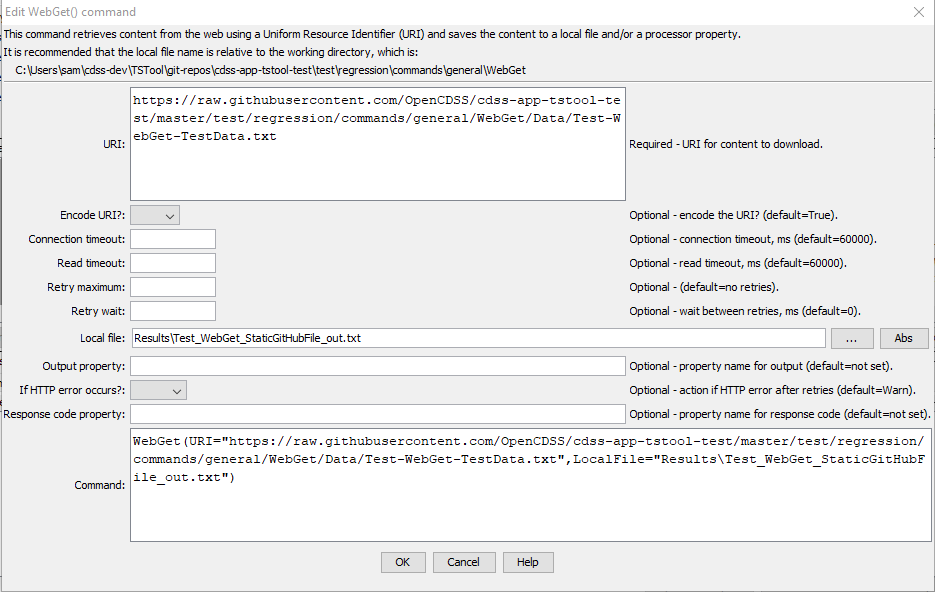TSTool / Command / WebGet
Overview
The WebGet command retrieves content from a website and writes the content to a local file.
The transfer occurs using binary characters and the local copy is the same as that shown by
View / Source (or View / Page Source) in a web browser.
This command is useful for downloading files and content from web services.
The local file can then be processed with additional commands, for example
ReadDelimitedFile if the content is comma-separated-value and
ReadTableFromJSON if the content is JSON.
Extraneous content (such as HTML markup around text) and inconsistencies in newline characters
(CRLF=\r\n for windows and LF=\n on other systems) may lead to some issues in processing the content with other commands.
See the TextEdit and other commands to process files after downloading.
Zipped files can be unzipped using the
See the UnzipFile command.
Command Editor
The following dialog is used to edit the command and illustrates the command syntax.

WebGet Command Editor (see also the full-size image)
Command Syntax
The command syntax is as follows:
WebGet(Parameter="Value",...)
Command Parameters
| Parameter | Description | Default |
|---|---|---|
URIrequired |
The Uniform Resource Identifier (URI) for the content to be retrieved. This is often also referred to as the Uniform Resource Locator (URL). Global properties can be used with the ${Property} syntax. |
None - must be specified. |
EncodeURI |
Indicate whether to encode the URL to protect special characters: False or True. See Percent-encoding on Wikipedia. Encoded URLs are difficult to read and therefore human-readable URL can be entered as the URI, such as using spaces. However, the requested resource may require encoding to be recognized by a called service. If the provided URI is already encoded, then specify False. Only the value part of ?property=value and &property=value query is encoded. |
True |
ConnectTimeout |
The connection timeout in milliseconds. If a connection has not occurred in this time, an error will result. | 60000 (60 seconds) |
ReadTimeout |
The read timeout in milliseconds. If data read has not started in this time, an error will result. For example, a connection may be established and the server may begin processing a response, but may not provide data to read. | 60000 (60 seconds) |
RetryMax |
Maximum number of retries, useful when a server rejects connections or is known to experience downtime. Using retries will cause the workflow to wait on this command. Another option is to use the For command to control retries. |
Try one time. |
RetryWait |
Wait time in milliseconds before retries, which is additional time that can be used in addition to ConnectTimeout and ReadTimeout to space retries. |
0 |
LocalFile |
The local file in which to save the content. Global properties can be used with the ${Property} syntax. |
Output file will not be written. |
OutputProperty |
Name of the processor property to set the retrieved contents. For example, a snippet of data can be set as a property for processing by other commands, in which case the content will be accessed using ${Property} notation. |
Content will not be set in a property. |
IfHttpError |
Indicate how to handle an HTTP return code other than 200:
|
Warn |
ResponseCodeProperty |
The HTTP response code returned by the request. This can be used to check whether the request was successful and control the workflow. Code 200 typically indicates success. |
Property value is not set. |
Examples
See the automated tests.